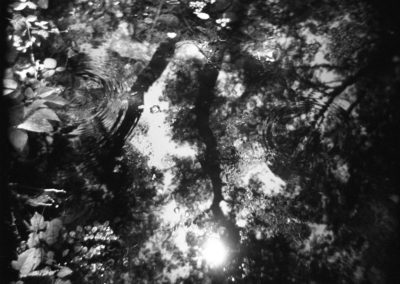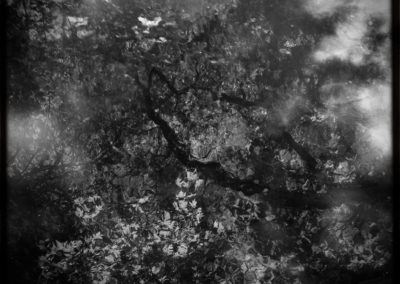“Passage through a landscape echoes or stimulates the passage through a series of thoughts”
Rebecca Solnit, Wanderlust
In British English, the word journey often means the most ordinary travel; for example, a commute to work. In contemporary American English, though, the word carries connotations of a metaphorical voyage, one in which we go not only from one physical place to another, but also from one internal “place” to another. In these photographs the two meanings meet, as an hour’s walk in a familiar place becomes a journey inward.

A walk
I begin the day’s walk with an intention – conscious or otherwise – to explore beneath the surface. I stay a moment, experiencing the solid complexities, the impenetrability of the place where my journey begins. Once this has made its impression, there’s a surfacing, almost as if I’m breaking the surface of the water (or the dream that is conscious life) to gather breath – and perhaps light, or imagery – for the time beneath. Then I begin a descent into the unconscious self, gradually at first, then becoming more fully immersed. Illuminations shift, different possibilities becoming visible. At times it seems as if I can see endlessly upward; at other times, I’m met with an equivalent, below the surface, of what’s above. I can imagine that this might in some sense be its deeper meaning. In this ethereal world, a more palpable reality offers grounding, a base from which to discover delicate, even vulnerable, possibilities forming and re-forming. As the exploration slows, stillness subtly changes everything. The shadow of the experience leads up and out, a path back to ordinary life. I return restored and changed, in ways that may not be quite susceptible to verbal description.

The project
These pictures are part of a collaborative project with Paul Romaniuk and Jan Gates. The project originated with Paul, who observed that there were both similarities and differences in the ways that each of the three of us combined walking with photographing. In a year’s geographically separate collaboration, we hoped to learn more about the ways in which this combination unfolds. One of the primary similarities among us in our photographic practices is that we all let our unconscious lead the process. As Ruth Bernhard wrote, “A photograph finds you; you do not look for a photograph. Your knowledge of yourself tells you, ‘Ah, that’s my thing. I am here for you.’” I hoped that the pictures I made in the course of this project would show visually one person’s experience, at one time, of moving toward “my thing,” that movement of consciousness from one “thing” to another. To do that, I’ve presented photos from one day’s walk in the order in which I actually made them.

Creativity from walking
The idea of a connection between walking and creative process has a rich history. There are long Buddhist and Christian traditions of walking meditation. Rousseau, Kierkegaard, and Nietzsche wrote about their experiences of walking as generating creativity of thought. This connection has been made not only in religion and philosophy, but also in science. For example, Darwin built a quarter-mile path at his home where he could walk to facilitate creative thinking. Recently, graduate student Marily Oppezzo and psychologist Daniel Schwartz conducted a series of experiments that showed that people are, in fact, more creative during and shortly after walking. They referred to what I’ve called letting the unconscious lead as an experience of “soft fascination,” which they described as not requiring direct attention.
Some artists see walking as an art form in and of itself. Hamish Fulton describes himself as a “walking artist” and has been quoted as saying, “The walking is the constant, the art medium is the variable.” Fulton speaks of “making a walk”, unlike the usual (American English) usage of “taking a walk,” which might potentially parallel the distinction between “making” and “taking” photographs. Some walking art incorporates photographs, but primarily as records of the walk, rather than (as Paul, Jan, and I have conceptualized them) as artworks in and of themselves, created through the walk.
A big thank you to J. M. Golding!
About J. M. Golding
J. M. Golding is an artist based in the San Francisco Bay area. Her work explores the emotional and symbolic significance of the natural world as it reflects internal, subjective experience.
You can contact and view more of J. M. Golding’s work through her website: www.jmgolding.com
Unless otherwise stated, all images and words in this article are © J. M. Golding












